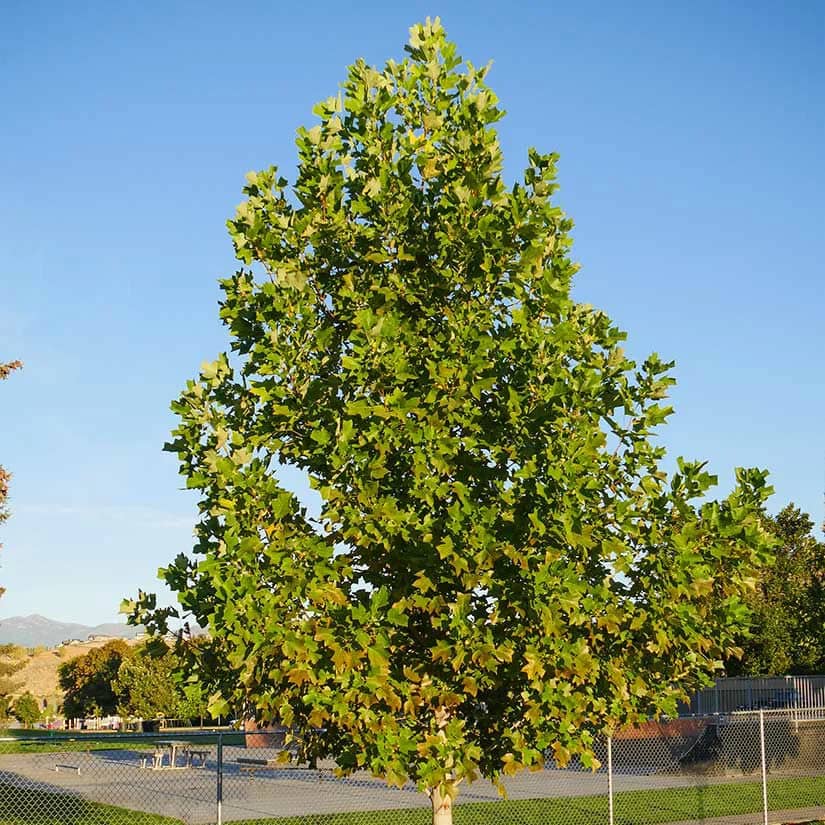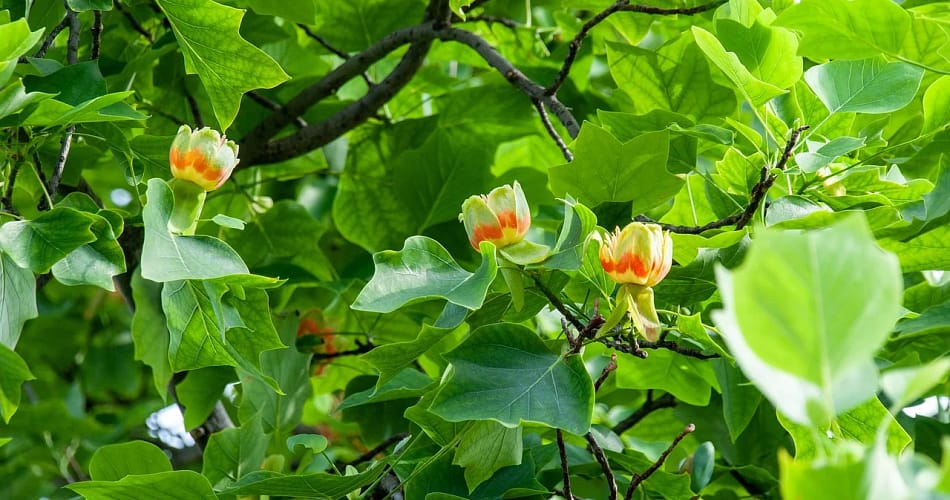Planting tulips is a rewarding experience that brings a burst of color and life to any garden. Whether you’re planting tulip bulbs in the fall for a spring bloom or caring for the majestic tulip tree throughout the year, this guide will walk you through everything you need to know about tulip planting. We’ll explore the different types of tulips, including the beautiful Tulipa Queen of Night, the care and maintenance of the tulip tree—also known as the Liriodendron tulipifera tulip tree—and much more. Let’s dig in!
Tulip Planting : Getting Started
The first step in successful tulip planting is choosing the right type of tulip for your garden. Tulips come in a variety of shapes, sizes, and colors, making them a versatile choice for any landscape. For a dramatic look, consider planting the Tulipa Queen of Night. This dark, almost black tulip adds a touch of mystery and elegance to your garden.
When planting tulip bulbs, timing is crucial. The best time to plant tulips is in the fall, about 6 to 8 weeks before the first frost. This allows the bulbs to establish roots before the ground freezes, ensuring a beautiful bloom in the spring. Make sure to plant the bulbs about 6 inches deep and 4 to 6 inches apart, with the pointed end facing upwards.
If You Want To Care Your Tulip Trees and Magnolias Click HereTulip Bulbs vs. Tulip Bulblets
One common question among gardeners is the difference between tulip bulbs and tulip bulblets. Tulip bulbs are the primary, mature bulbs that you plant in the ground to grow tulips. These bulbs are typically large and firm, ensuring they have the energy to produce a robust flower.
On the other hand, tulip bulblets are smaller, younger versions of the main bulb. These bulblets usually form around the base of the mother bulb and can be used to propagate new tulip plants. However, it may take a few years for tulip bulblets to mature and produce flowers.
How To Grow Tulip Bulbs Click Here : https://indoorplantation.com/tulip-planting-guide/The Majestic Tulip Tree: Liriodendron Tulipifera
The Liriodendron tulipifera tulip tree—also known as the American tulip tree or tulip poplar tree—is a magnificent addition to any garden or landscape. Despite its name, this tree is not related to the tulip flower but gets its name from the tulip-shaped flowers it produces.
The tulip tree is one of the tallest native trees in North America, growing up to 100 feet tall. Its large, yellow-green flowers appear in late spring to early summer, attracting bees and butterflies. The tree’s leaves are also distinctive, with a unique, lobed shape that adds visual interest throughout the year.
Caring for the Liriodendron Tulipifera Tulip Tree

Caring for a Liriodendron tulipifera tulip tree is relatively easy, as this tree is hardy and adaptable. It thrives in full sun and prefers moist, well-drained soil. However, it can also tolerate a range of soil types, from sandy to clay.
Regular watering is essential, especially during the tree’s first few years of growth. Once established, the tulip tree is relatively drought-tolerant, though it will benefit from occasional deep watering during dry spells. Pruning is generally not necessary, except to remove any dead or damaged branches.
Click Here To Exploring the Majesty of the Tulip PoplarThe African Tulip Tree: Spathodea Campanulata
The African tulip tree (Spathodea campanulata) is another stunning variety that is popular in tropical and subtropical regions. This tree is known for its vibrant orange-red flowers that bloom in clusters, making it a striking focal point in any garden.
Unlike the Liriodendron tulipifera tulip tree, the African tulip tree is not native to North America. It originates from Africa and thrives in warm climates, making it ideal for regions like Florida or Hawaii. The African tulip tree can grow up to 80 feet tall and prefers full sun and well-drained soil.
Challenges with the African Tulip Tree
While the African tulip tree is undeniably beautiful, it can also be invasive in certain areas. In places like Hawaii and Australia, this tree has become a problem due to its aggressive growth and ability to outcompete native species. If you’re considering planting an African tulip tree, it’s essential to check with local guidelines to ensure it’s a suitable choice for your area.
Common Tulip Planting Problems Click HereExploring Other Tulip Tree Varieties
In addition to the Liriodendron tulipifera tulip tree and the African tulip tree, there are other varieties worth exploring:
- Yellow Poplar Tree: Often confused with the tulip tree, the yellow poplar tree is another name for the Liriodendron tulipifera. This tree is known for its fast growth and tall stature, making it a popular choice for landscaping.
- Black Tulip Magnolia: While not a true tulip tree, the black tulip magnolia (Magnolia x soulangeana) is a stunning flowering tree that produces deep purple, tulip-shaped flowers in the spring. This tree is smaller than the Liriodendron tulipifera and is perfect for smaller gardens or as a focal point in a landscape.
Best Practices for Tulip Tree Care
When caring for any tulip tree variety, there are a few best practices to keep in mind:
- Soil: Ensure the soil is well-drained and rich in organic matter. Adding compost or mulch around the base of the tree can help retain moisture and improve soil quality.
- Watering: Water your tulip tree regularly, especially during dry periods. Young trees require more frequent watering until they are well-established.
- Pruning: While tulip trees generally require minimal pruning, it’s essential to remove any dead, damaged, or diseased branches to promote healthy growth.
- Fertilizing: Fertilize your tulip tree in the spring with a balanced fertilizer to encourage vigorous growth and blooming.
Click Here To Know The Beauty of Pink TulipsTulip Planting for Different Climates
Tulip planting can vary depending on your climate. In colder regions, tulip bulbs should be planted in the fall, giving them time to establish roots before winter. In warmer climates, it may be necessary to pre-chill the bulbs before planting to simulate winter conditions.
For tulip trees, the planting season can be more flexible. However, planting in the spring or fall is generally recommended to avoid the extremes of summer heat or winter cold.
Know About Tulip Leaves TreeTulip Planting in Containers
If you don’t have garden space, don’t worry—you can still enjoy tulips by planting them in containers. Tulip planting in containers follows the same principles as garden planting, with a few key differences:
- Choose the Right Container: Select a container with good drainage, as tulips do not like to sit in waterlogged soil. A depth of at least 8 to 10 inches is ideal.
- Use High-Quality Potting Mix: Fill the container with a well-draining potting mix enriched with compost. Avoid using garden soil, as it can become compacted and limit root growth.
- Planting Depth: Plant the tulip bulbs about 4 to 6 inches deep, with the pointed end facing up. Space the bulbs closely together for a full, lush look.
- Winter Care: In colder climates, protect the containers from freezing by moving them to a sheltered location or wrapping them with insulation. In warmer regions, the containers can remain outdoors.
Click Here To Understanding Tulip Roots
Troubleshooting Common Tulip Planting Issues
Even with the best care, tulip planting can sometimes encounter problems. Here are a few common issues and how to address them:
- Poor Blooming: If your tulips are not blooming as expected, it could be due to inadequate chilling of the bulbs, poor soil conditions, or overcrowding. Ensure the bulbs are planted at the correct depth and spacing and that they receive enough sunlight.
- Pests and Diseases: Tulips can be affected by pests like aphids, slugs, and rodents. Use organic pest control methods or barriers to protect your plants. Diseases such as tulip fire or bulb rot can also occur, so it’s crucial to plant healthy bulbs and avoid overwatering.
- Yellowing Leaves: Yellow leaves on a tulip tree may indicate water stress, nutrient deficiency, or root problems. Ensure the tree is receiving adequate water and consider applying a balanced fertilizer.
Click Here To Know About The Majestic Chinese Tulip TreeCreating a Tulip-Themed Garden
For a truly stunning garden, consider creating a tulip-themed space that showcases the beauty of both tulip bulbs and tulip trees. You can mix and match different varieties of tulips, from the classic red and yellow blooms to the exotic Tulipa Queen of Night. Incorporate a Liriodendron tulipifera tulip tree or African tulip tree as a centerpiece, and surround it with complementary plants that bloom at different times of the year.
FAQs
What is the best time for tulip planting?
The best time for tulip planting is in the fall, about 6 to 8 weeks before the first frost. This gives the bulbs time to establish roots before winter.
Can I grow tulips in containers?
Yes, tulips can be grown in containers. Use a well-draining potting mix and a container with good drainage. Plant the bulbs at the correct depth and protect them from extreme temperatures.
What is the difference between tulip bulbs and tulip bulblets?
Tulip bulbs are mature, large bulbs that produce flowers, while tulip bulblets are smaller, younger versions of the bulbs. Tulip bulblets can be used to propagate new plants but may take a few years to mature.
How do I care for a Liriodendron tulipifera tulip tree?
The Liriodendron tulipifera tulip tree requires full sun, well-drained soil, and regular watering, especially in its early years. Pruning is generally minimal, but it’s important to remove any dead or damaged branches.
Is the African tulip tree invasive?
In some regions, the African tulip tree can be invasive due to its aggressive growth. It’s important to check local guidelines before planting this tree.
What is a Tulipa Queen of Night?
The Tulipa Queen of Night is a unique variety of tulip with dark, almost black petals. It adds an elegant and mysterious touch to any garden.

